
It is an expression that is echoed even today, when it is possible to see them on tiny key chains or on 200-ton walls. In China, the dragon, or "lung" is the repository of all the qualities we crave: wisdom, courage, nobility, strength, beauty... This mythical animal is considered a common ancestor, an entity of the very character of the Chinese people. A ubiquitous symbol of good fortune, with totems scattered across the country.
You can't be precise when the dragon myth appeared in China. It is estimated to have been 8,000 years ago. Its earliest representation was discovered in 1987, in Henan province, south of Beijing. It was a dragon made of shells buried in the same grave as a man of the Yangshao culture, about 6,000 years old. Another excavation, in Inner Mongolia, north of the country's capital, found a jade dragon more than 5,000 years old. Its body, coiled like a snake's, had a head like a pig's.
This amalgamation of animals gave researchers fertile ground, for hypotheses about the formation of the dragon icon. The most accepted credits its genesis to the powerful Huaxia clan, which after successive wars unified tribes and had a great influence in the formation of the Chinese people. The Huaxia lived 5,000 years ago along the Yellow River, which cuts the country's north from the center to the Bohai Sea in the east. His totem was a snake. With each victory over opponents, the Huaxia added a portion of the totem won to their own animal.
Currently, even with small discrepancies, the most common configuration shows the Chinese dragon with snake body and carp scales, rabbit eyes, bull ears, deer horns, tiger's paws and eagle's claws, and parts of others animals, its head being that of a horse and even a camel. Despite the rich and variable fauna of its body, one thing has remained intact over the centuries: its benevolent character. The Chinese dragon has always been a sign of good fortune, spiritual and material wealth.
Without the moral burden of Judaism and Christianity and accustomed to worshiping animals, the Chinese raised the dragon to a special post of worship. He personifies nature itself. With powers over the four elements, but especially over water, he would be the responsible for the rains. Even today farmers make offerings in small temples, the pagodas, asking for good weather and plentiful harvests. Like every deity, however, the dragon is also vain. Even revengeful.
Natural disasters are credited to them as punishment for offenses committed by human beings. Your kindness, however, is indisputable, and this is the main feature that differentiates it from Western dragons, almost always malevolent. Otherwise they are. similar, observing small subtleties. he chinese dragon
it also breathes fire, but it has only one head. It lives in the seas and rivers or in the mountains and clouds and flies without wings. It can change color and disappear, transmute into other animals and even people.
Thank you so much for reading this far!
Congratulations @ralexandria! You have completed the following achievement on the Hive blockchain and have been rewarded with new badge(s) :
Your next target is to reach 1750 upvotes.
You can view your badges on your board and compare yourself to others in the Ranking
If you no longer want to receive notifications, reply to this comment with the word
STOPCheck out the last post from @hivebuzz:
Support the HiveBuzz project. Vote for our proposal!
Source of plagiarism
Direct translation without giving credit to the original author is Plagiarism. Repeated plagiarism is considered fraud. Fraud is discouraged by the community and may result in the account being Blacklisted.
Guide: Why and How People Abuse and Plagiarise
Please note that direct translations including attribution or source with no original content are considered spam.
If you believe this comment is in error, please contact us in #appeals in Discord.